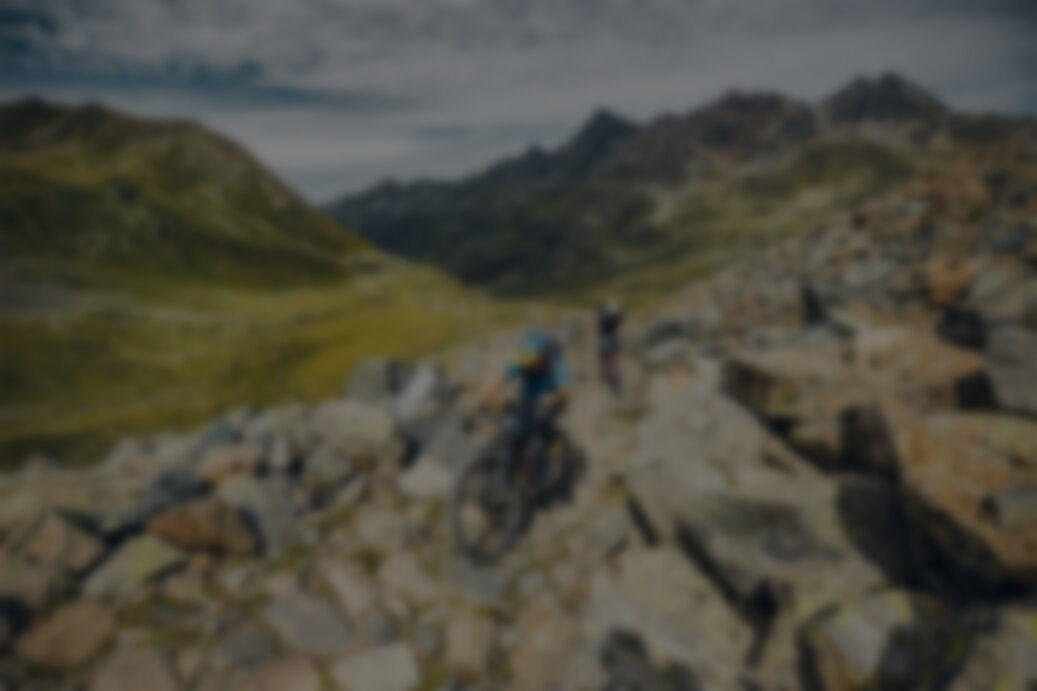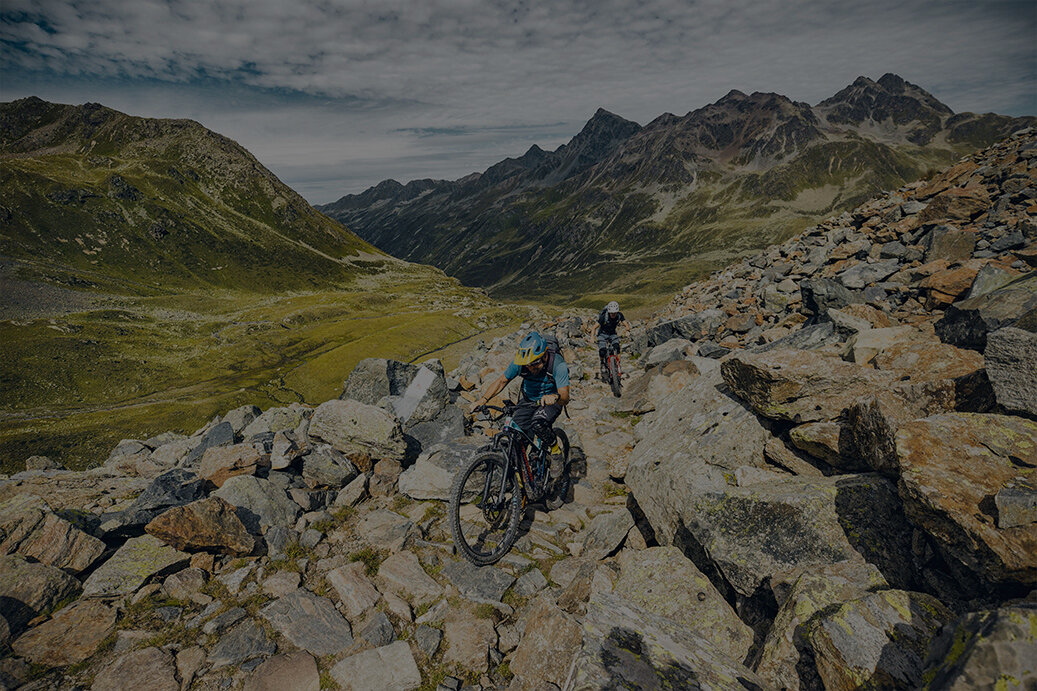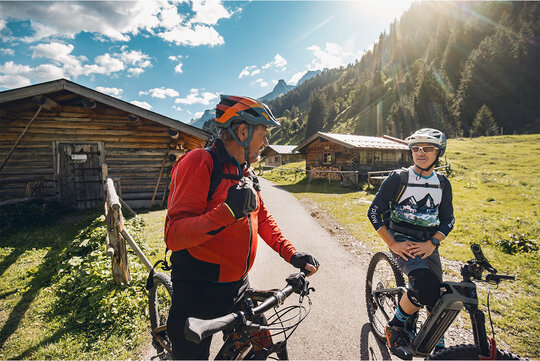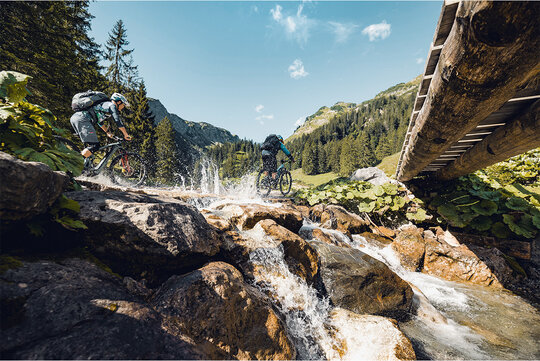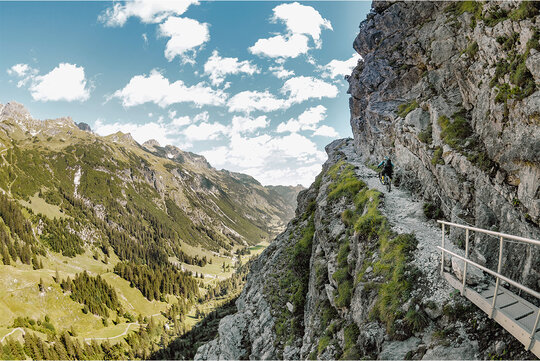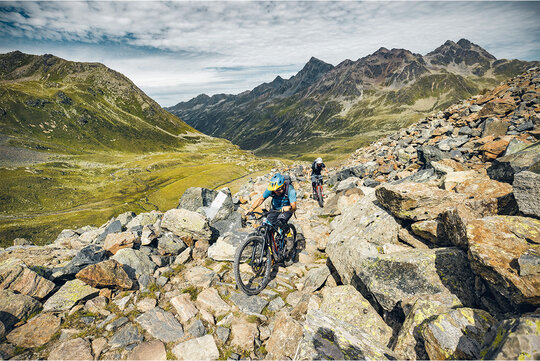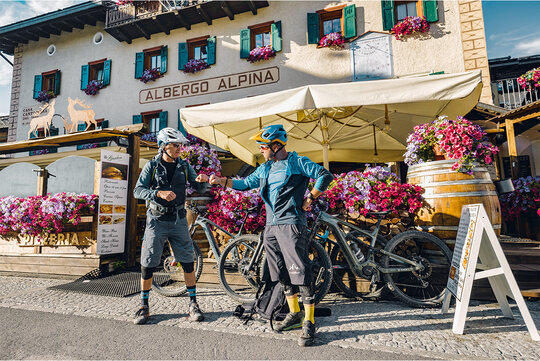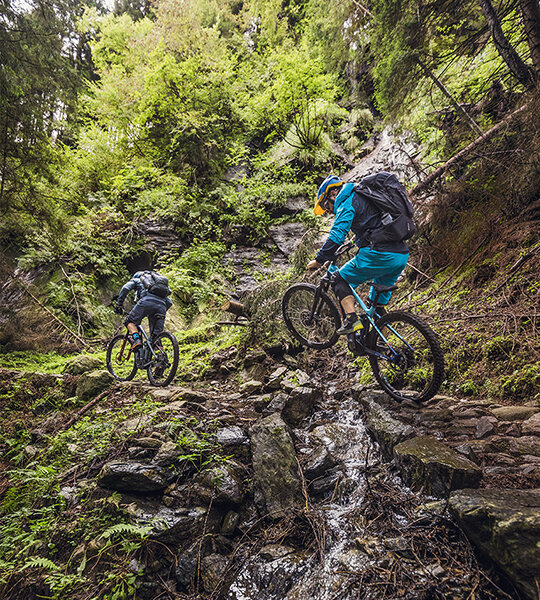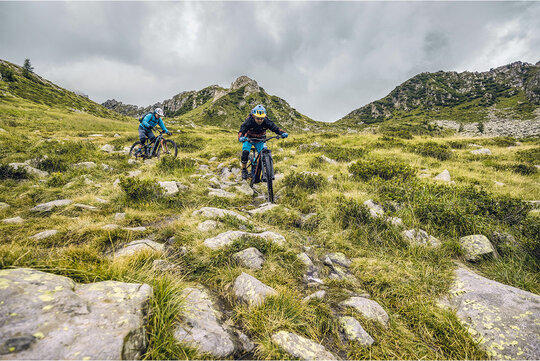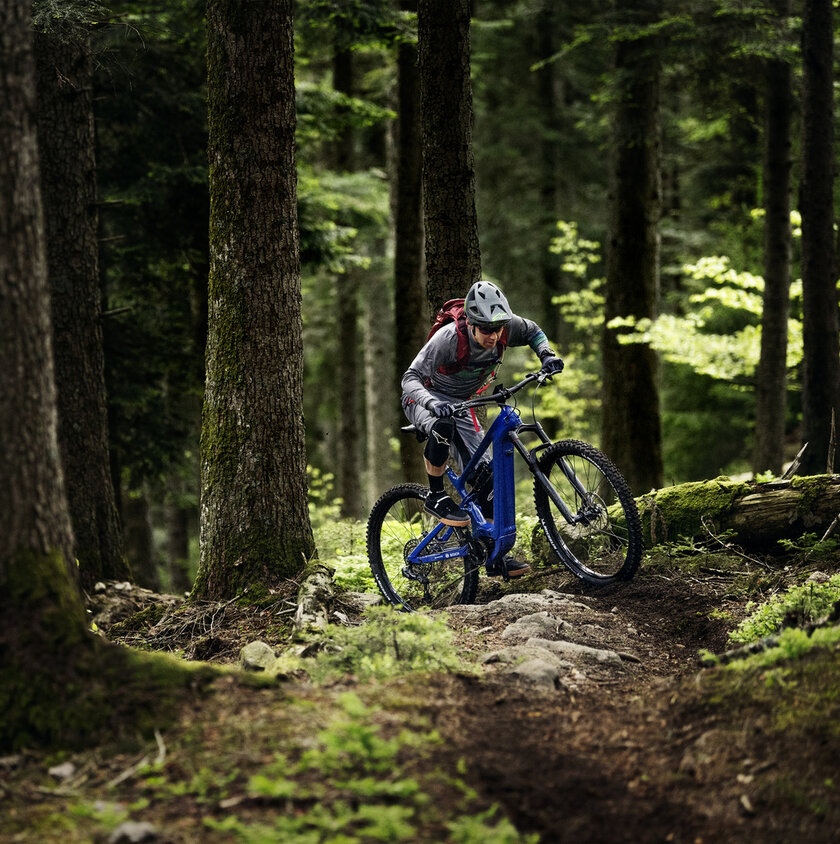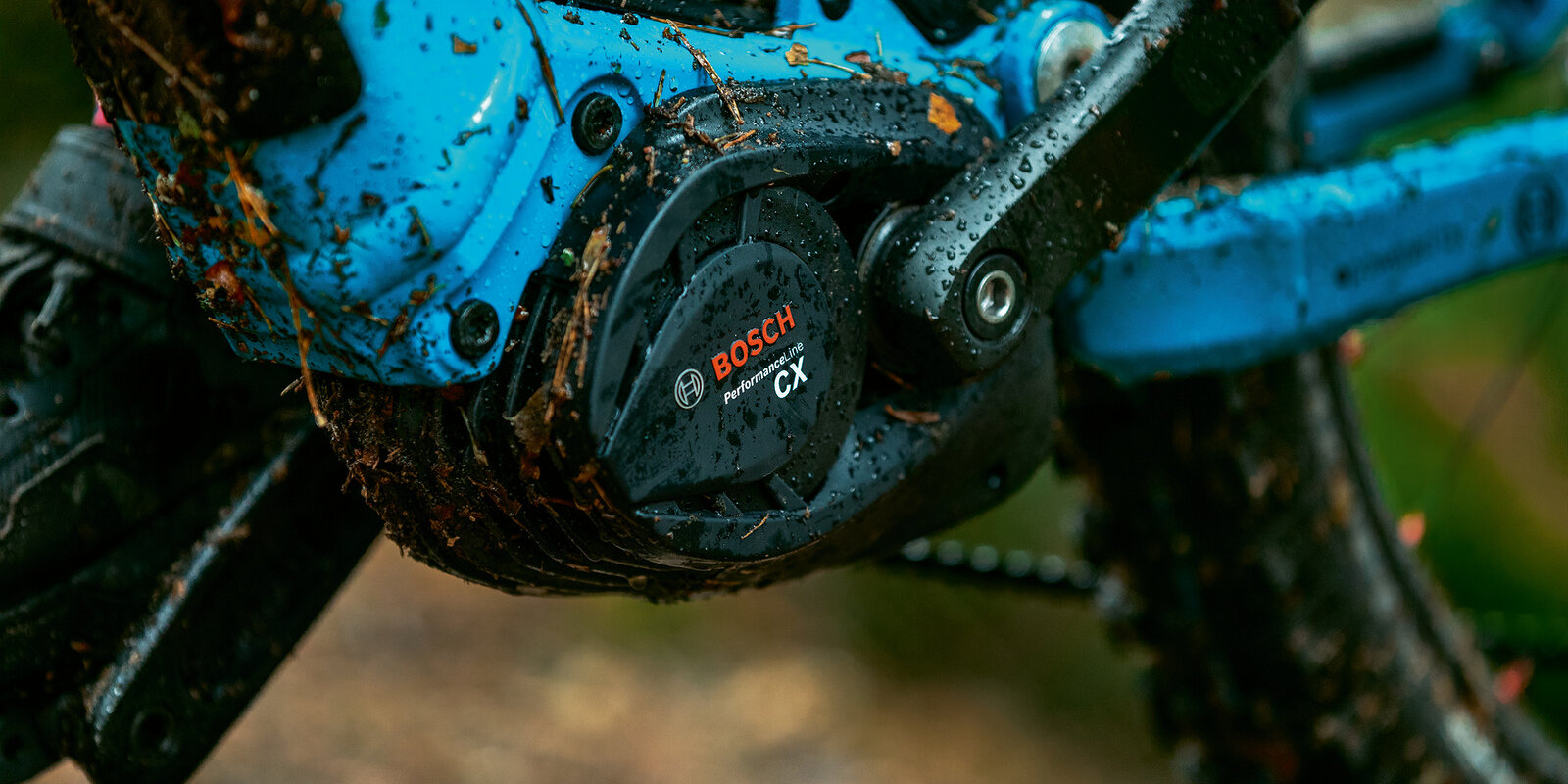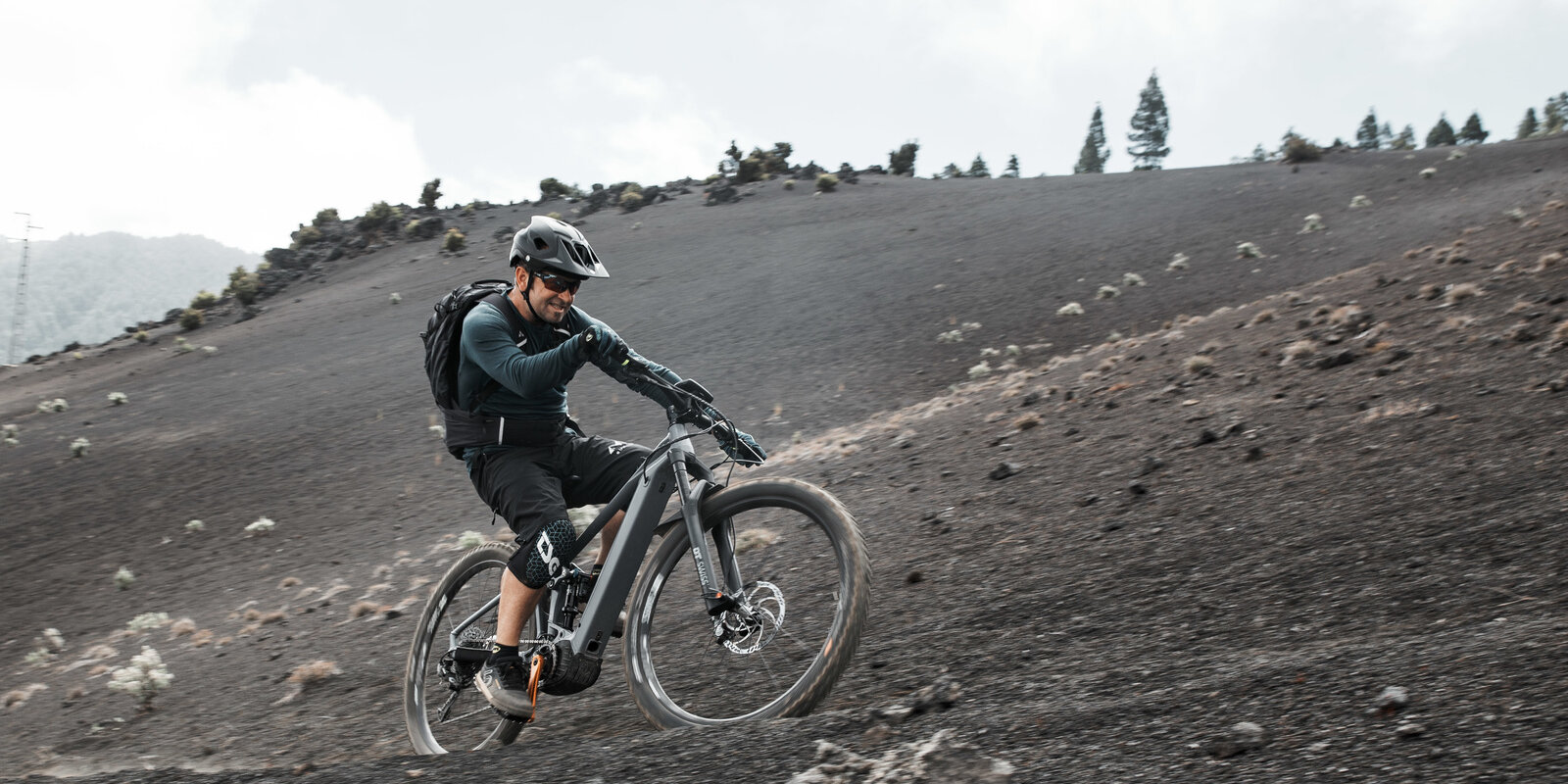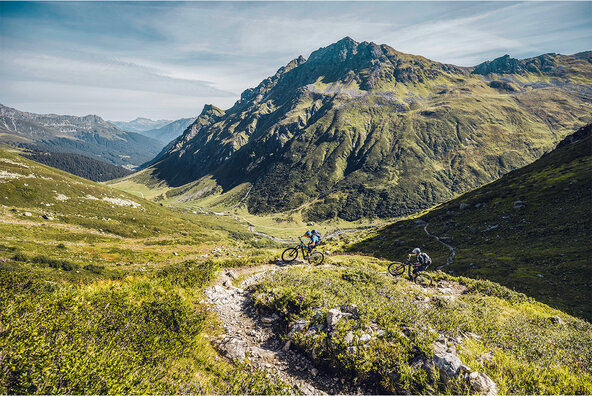
The Alps have been a special place for adventure and pioneering achievements for centuries. Located in the heart of Europe, these peaks have been inspiring countless people to turn their dreams into reality for decades. 30 years ago it was Andi Heckmair who set a milestone for mountain bikers when he crossed the Alps. Starting from Oberstdorf in Germany he took a very direct line over the passes in Austria and Switzerland to reach Riva on Italy's Lake Garda.
The Heckmair route is considered an absolute classic and covers about 400 kilometres and 13,500 metres of altitude. The bike has to be pushed or carried at certain points along the way. Is that fun when you've got an eMTB? Claus Fleischer, CEO of Bosch eBike systems, and mountain bike pro Stefan Schlie tried it out.
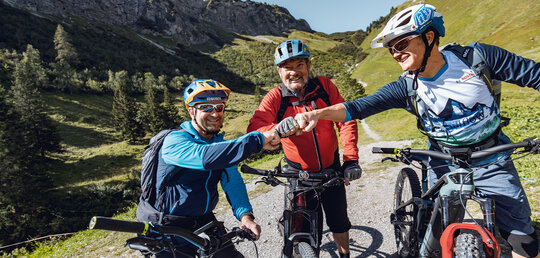
On the legendary trail: mountain bike pro Stefan Schlie (left) and Claus Fleischer (right), CEO of Bosch eBike systems, are accompanied by transalpine pioneer Andi Heckmair for the first 15 kilometres.
The idea
"Ötzi made the crossing on foot, Hannibal took a pack of elephants, Paulcke used skis – but no one had done it with a mountain bike." This is how Andi Heckmair is quoted when he set a milestone in mountain biking history by crossing the Alps on his bike in 1990. His father Anderl was the first to climb the Eiger north face, but Andi took to his bike instead: The Heckmair route leads from Oberstdorf in Bavaria to the shores of Lake Garda, about 400 kilometres across the Alps, on narrow paths and over a total of 13,500 metres in altitude. It was an endeavour Heckmair said in an interview that you'd have to have "masochistic tendencies" to attempt with a 25-kilogram eMTB.
That statement was the goad to try just that. Every summer, Claus Fleischer, CEO of Bosch eBike systems, and multiple runner-up Trials World Champion Stefan Schlie take a research trip together to get to know the various mountain bike tourism concepts in the Alps, gather new ideas and explore the possibilities of modern eMTB systems.
Their journeys reflect the spirit in which Bosch eBike systems was founded in 2009 as a start-up within the Bosch Group, leading to significant advances in eMTB development in recent years. Now, 30 years after Andi Heckmair's first crossing of the Alps, they decided to try the Heckmair 2.0 adventure – this time with electric drive units.
Planning
"You guys are nuts - that's a crazy idea. We're in" – the response from everyone Claus and Stefan asked for support. Markus Greber, photographer and journalist, eventually accompanied them on the Tour, while transalpine expert Uli Stanciu assisted with GPS tour planning. The route included various sections where the eMTB needed to be pushed or carried, a real grind on the Schrofen Pass on the border between Germany and Austria, the Schlappiner Joch on the way into Switzerland and finally at Passo di Campo in Italy. They decided to do it anyway, four countries in four days instead of six, including a number of tricky passages. Claus says: "Otherwise, it wouldn't be a true Heckmair Route 2.0 for us."
Claus and Stefan prepared for the trip using the GPS data on their Nyon display units. They decided on four stages covering all original passes of Heckmair's route plus one reserve day. The only exception was the section after Livigno, an Italian ski resort on the border with Switzerland, where Uli Stanciu planned a more scenic variant through the Valdidentro and Val Verva, instead of the paved route over the Gavia Pass.
Day 1
Departure at the foot of the Alps
The adventure starts early in the morning in Oberstdorf on the German side of the Alps, with spare batteries and a charger in a rucksack and other spare parts in the support vehicle. On the first 15 kilometres to the entrance to the Schrofen Pass, which takes them from Germany to Austria and which represents the highlight of many trips, especially for mountain bikers, Claus and Stefan are accompanied by the now 79-year-old pioneer Andi Heckmair.
When he set out 30 years ago, tourism in the Alps was quite different. It was only later, when increasing numbers of people were attracted to the Alps, that discussions flared up: hikers and mountain bikers share centuries-old mule trails and trade routes. The eMTB is now also part of the debate. The electric drive and the range of the rechargeable battery can help keep congested routes clear, as well as enabling paths far off the beaten track to be explored. "The Alps are not generally overcrowded, however conditions can get congested at certain points," said mountaineering legend Reinhold Messner. "One valley further over, the Alps are completely empty." The battery support is a great help in leaving the hotspots behind, but consideration, tolerance and respect between people as well as for nature always helps. This is true whether you enjoy the mountains on foot or by bike.
For Claus and Stefan the first day in the saddle ends after five hours and 32 minutes of active time in the saddle – with two batteries and recharging during the breaks they have covered the first 92 kilometres and 3,250 metres of altitude.
Day 2
Uphill Flow fireworks in Switzerland
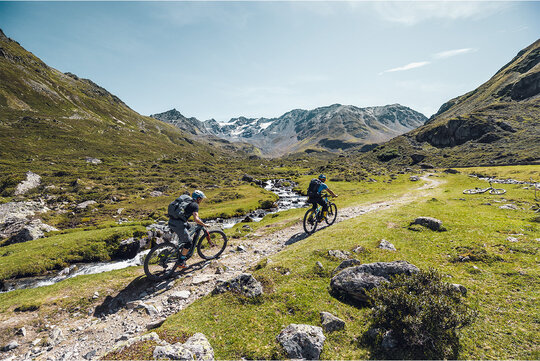
The calm before the storm: on their way to the Scalettapass Claus and Stefan ride their eMTBs up the trail, which is still easy going.
The second day starts with a feat of strength at the Schlappiner Joch on the way from Austria to Switzerland, 400 metres in altitude over 1.5 kilometres. Barely rideable, a narrow, steep climb, part of which is still blocked, forces you to push – or carry your bike. But after a lunch break in Davos, Switzerland, Claus and Stefan can fully enjoy the fascination of the eMTB on the ascent to the Scaletta Pass as they head for Italy. "A firework of uphill flow trails," says Stefan. Uphill flow is the feeling of being one with the trail - not only downhill but also uphill. He and Claus had already developed this idea in 2013.
Spurred on by exhilaration, the team traverses Switzerland from north to south and finally reaches Livigno via the completely ridable Chachauna Pass – 5:44 hours of riding time, 85 kilometres, 3,700 metres of altitude difference. In the skies of the Italian Alps, low rain clouds and high winds already herald the challenges of the coming days.
Day 3
Italian bad weather test
Dark clouds and strong winds accompany the pair from Livigno through the Val Alpisella as they head for the man-made lakes north-west of Bormio. The trails become a real challenge due to the weather, so good riding technique becomes essential. The ideal bike and foot position, the correct pedalling sequence and pedal position – if you want to push the limits with your eMTB and still be safe, good riding technique is key.
It's raining cats and dogs as they pass through the Italian Alps in Valdidentro and Val Verva, but still in good spirits. At the top of the pass, the wispy clouds part and isolated rays of sunlight light up the bizarre mountainous world, as the mist rises from between the boulders. After 118 kilometres, 3,450 metres of altitude and almost six hours of riding, the group reaches the finish at the foot of the Adamello mountains.
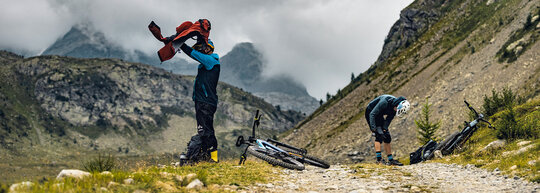
Dark omens: strong winds and clouds herald bad weather. Heavy rain makes the trails through Val Alpisella, Valdidentro and Val Viola a challenge.
Day 4
Arrival and outlook
The final leg is delayed. Stormy weather settles on the Alps for two days, making the last and decisive stage seem impossible. What now? Leave or wait for one last opportunity? That would mean two days of enforced rest and crossing the notorious Passo di Campo at dawn.
They still want to complete the Heckmair 2.0 and, after 48 hours of waiting around, set off up to Passo di Campo. Partially blocked, a steep, slippery cart path leads ever upwards through a fairytale forest still wet from the rain. Were they able to use their eMTBs? Of course, in Uphill Flow! Contrary to the warnings, they only have to walk a little and can ride more than expected, crossing sections of knotted roots, rock gardens and slabs. Here, too, the best riding technique and alpine experience are required. This pass is not for beginners. At 2,250 metres there is a nice surprise after the last challenge of the Passo di Campo. Uli Stanciu and his wife Gio are already waiting for the group with a well chilled Nosiola from Trentino.
After the fun of the uphill trail, the steep descent to Lago di Campo awaits. Full of euphoria and gratitude, Claus, Stefan and companion Markus arrive exhausted and happy at their destination – a moment they will remember forever. The well-known final stage over the Tremalzo Pass to the final destination in Riva del Garda has to be cancelled due to time constraints.
A summary of the Heckmair 2.0 adventure and the Alpine crossing by eMTB?
"You can do it, but you don't have to" says Claus with a laugh.
The key sections of the ride, which took them through four countries in four days, were doable with a 22.5kg eMTB. They wouldn't recommend the Schlappiner Joch between Austria and Switzerland; but without it, it wouldn't really have been Heckmair 2.0. A lot has changed since Andi Heckmair crossed the Alps in 1990, both in the Alps and on the bikes themselves. What will a crossing of the Alps by eMTB be like in the future? "Our digital innovations will soon open up a whole new range of possibilities, especially in terms of personalising the riding sensation, connectivity and navigation," says Claus. "I can hardly wait for our next research trip. Who knows, maybe we'll try Heckmair 3.0 at some point – with some variations and including the final stage."
Bosch eBike Facts
